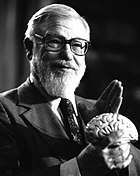Psychomotor patterning
Psychomotor patterning, rarely referred to as the Doman-Delacato technique, is a pseudoscientific approach to the treatment of intellectual disabilities, brain injury, learning disabilities, and other cognitive diseases.[1] The treatment is based on the largely discredited[1] hypothesis that ontogeny recapitulates phylogeny. The method assumes that intellectual disabilities results from the failure of an individual to develop properly through the phylogenetic stages, and treatment primarily focuses on non-invasive physical therapy in each of these stages. In one such stage, the homolateral stage, a healthy child typically crawls by turning the head to one side while extending the arm and leg of the opposite side. The patterning treatment is applied to those unable to perform this motion, and involves passive intervention by 4-5 adults who assists the child in an effort to impose or induce the proper pattern onto the central nervous system. The therapy normally lasts for 5 minutes and is repeated at least 4 times a day. Full treatment programs typically contain a range of exercises combined with sensory stimulation, breathing exercises designed to increase oxygen flow to the brain, and systematic restriction and facilitation designed to promote hemispheric dominance.

The treatment modality of patterning was developed in the 1960s by Glenn Doman and Carl Delacato.
Robert Doman, the nephew of Glenn Doman, set up an institute called the National Academy of Child Development (NACD) in Utah in 1979 that offers patterning as part of its treatment program for children with many different developmental disorders.[1][2] It calls its treatments "targeted developmental interventions", a phrase it trademarked.[3] Some people associated with this institution refer to themselves as "neurodevelopmentalists".[4] There is a Christian spinoff organization called the International Christian Association of Neurodevelopmentalists (ICAN); as of 2009 both NACD and ICAN were popular among people who homeschool their children.[5]
References
- Novella, Steven (February 9, 2008). "Psychomotor Patterning: A Critical Look". Quackwatch.
- "Robert J. Doman Jr. - Founder and Director". NACD International. Retrieved 10 January 2017.
- "TDI TARGETED DEVELOPMENTAL INTERVENTION Trademark of National Association for Child Development, Inc. - Registration Number 3719427 - Serial Number 77477135". Justia. Retrieved 10 January 2017.
- "Ellen R. Doman". NACD International. Retrieved 10 January 2017.
- Hendrickson, Laura (2009). Finding Your Child's Way on the Autism Spectrum: Discovering Unique Strengths, Mastering Behavior Challenges. Moody Publishers. p. 124. ISBN 978-1-57567-316-5.
Further reading
- Ziring, Philip R.; Brazdziunas, Dana; Cooley, W. Carl; Kastner, Theodore A.; Kummer, Marian E.; González De Pijem, Lilliam; Quint, Richard D.; Ruppert, Elizabeth S.; Sandler, Adrian D. (1999). "The Treatment of Neurologically Impaired Children Using Patterning". Pediatrics. 104 (5): 1149–51. doi:10.1542/peds.104.5.1149. PMID 10545565.
- Johnson, Dan (July 21, 2004). "Will Baby Crawl?". National Science Foundation.